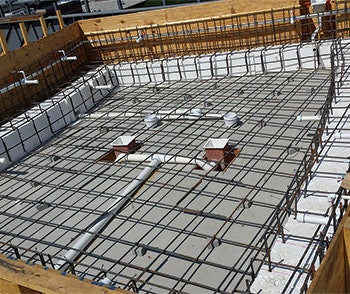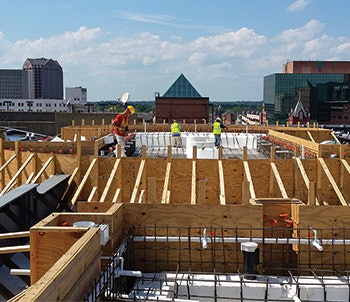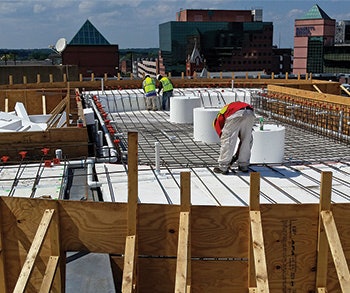When Genco Pools was approached about incorporating a roof deck swimming pool into a parking structure at the Hub at Columbia (Columbia, S.C.), Genco Principal Dan Ball immediately knew outside-the-box thinking would be required.

"Genco has been building pools and water features for both commercial and residential applications for more than 27 years, but this project really pushed us to think differently about pool construction," Ball says. In the case of the Hub at Columbia, an 850-bed apartment complex that largely serves students at the University of South Carolina, the pool was being added between the top two floors of the existing parking deck.
"Because the pool was being built into an existing structure, we were really challenged to think creatively about how to develop the desired shape and depths without adding any more weight than necessary," Ball says.
In a typical build, support for the pool shell would come from stone or cement, but those materials would have added intolerable weight and structural stress to a rooftop project such as this. Stainless steel wasn't an option due to budget constraints, so Ball began thinking about lighter, less expensive alternatives.

He had already used geofoam on a much smaller project and wondered if the product could solve this much larger pool support challenge. After making some calls and doing some homework, he found that at about 1 percent the weight of traditional earth materials, engineered expanded polystyrene foam offered a compressive strength high enough to support the pool without overloading the deck.
"Despite being so lightweight compared to earth or concrete, the compressive strength of geofoam is really tremendous. This allowed us to accommodate the full range of desired pool depths and even helped form the curved shape of the pool," said Ball. After assessing the required fill density for each section of the pool, Dan's team at Genco worked directly with ACH Foam Technologies in a design-build process to have each required piece of foam cut to exact specifications. The thickest pieces were 36 inches while the thinnest pieces were just 6 inches, and each one was cut within less than two inches of differential by the manufacturer prior to being delivered to the site.

"The foam pieces come to you already shaped to the profile of the pool," Ball says. "We gave the manufacturer a copy of the drawing, and that dictated the thickness and shape of the foam. The only thing we had to do is cut the foam and place our pipes inside. Then we shot the [concrete] over the foam to create the pool."
As with any urban pool project, logistics were a challenge. Located on Main Street in Columbia, the project site sat amid a bustling commercial city center with little room for construction traffic or roadway closures to accommodate craning operations. Realizing that simply getting this volume of material to the roof deck was going to be something of a mission, the Genco team worked with ACH Foam Technologies to develop a "just in time" delivery strategy where all of the required foam would be craned from trucks on the street to the roof deck in a single night.

"The city told us we could only have a piece of a lane on Main Street after 10 p.m. at night, so we worked with the manufacturer to have the product delivered through the night," said Ball. "As the foam arrived, it was craned directly up to the roof deck of the parking structure, and everything was out of the way so the street could be opened back up for normal morning traffic."
Don't Let It Snow!
Even after more than 25 years in the pool construction industry, Ball is pretty sure his team couldn't have completed this particular project without using ACH Foam Technologies' EPS geofoam. As for other suitable applications, Ball says, "I would use it on any elevated pool or place where weight is an issue. Like on the coast, if you're building in a V zone. Typically in that situation you've got to build a foundation for the pool to sit on, usually with stone. That would be easier with foam. It eliminates a machine, it eliminates the stone delivery and a lot of other issues."
Ball had one final tip for builders who might be considering using the material on a project. Take it from a builder who learned the hard way about cutting up polystyrene foam on a downtown rooftop:
"You want to heat-cut the foam," he says with a laugh. "If you cut it with something else, you make it snow all over the city."
No Tolerance For DeviationAmong the unusual and interesting aspects of this construction was the pool design, which called for a water level equal to the surrounding deck. Ball negotiated this challenge using two pieces of coping stone — one wet on the pool side, the other dry on the deck side. "There's a 1/2-inch slit between the two, and as the water comes from the pool over the wet coping it drops into that half-inch slit, and then drops into a gutter with a gravity feed back to a surge tank. "You have to be almost perfect on the elevation, or you'll have dry coping stones on the pool side. You can't be a 16th of an inch off, so we were very careful in setting the stone, and we had to shoot it every four or five feet, and even with that we had to go back and make some adjustments. "Sometimes you can overcome a tiny bit of variance, depending on how much water you have flowing over the edge, but that pool has about 200 perimeter feet, so it's very difficult with that many perimeter feet to get enough water flowing over the edge to hide much variance." |
Comments or thoughts on this article? Please e-mail [email protected].







































